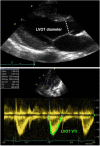Echocardiographic Evaluation of Ventricular Function-For the Neonatologist and Pediatric Intensivist
- PMID: 29670871
- PMCID: PMC5893826
- DOI: 10.3389/fped.2018.00079
Echocardiographic Evaluation of Ventricular Function-For the Neonatologist and Pediatric Intensivist
Abstract
In the neonatal and pediatric intensive care setting, bedside cardiac ultrasound is often used to assess ventricular dimensions and function. Depending upon the underlying disease process, it is necessary to be able to evaluate the systolic and diastolic function of left and or right ventricles. The systolic function of left ventricle is mostly assessed qualitatively on visual inspection "eye-balling" and quantitatively by measuring circumferential fraction shortening or calculating the ejection fraction by Simpson's planimetry. The assessment of left ventricular diastolic function relies essentially on the mitral valve and pulmonary venous Doppler tracings or tissue Doppler evaluation. The right ventricular particular shape and anatomical position does not permit to use the same parameters for measuring systolic function as is used for the LV. Tricuspid annular plane systolic excursion (TAPSE) and S' velocity on tissue Doppler imaging are more often used for quantitative assessment of right ventricle systolic function. Several parameters proposed to assess right ventricle systolic function such as fractional area change, 3D echocardiography, speckle tracking, and strain rate are being researched and normal values for children are being established. Diastolic function of right ventricle is evaluated by tricuspid valve and hepatic venous Doppler tracings or on tissue Doppler evaluation. The normal values for children are pretty similar to adults while normal values for the neonates, especially preterm infants, may differ significantly from adult population. The normal values for most of the parameters used to assess cardiac function in term neonates and children have now been established.
Keywords: bedside cardiac ultrasound; echocardiography; functional echocardiography; intensive care; neonatology; pediatric; point-of-care; ventricular function.
Figures










References
Publication types
LinkOut - more resources
Full Text Sources
Other Literature Sources

